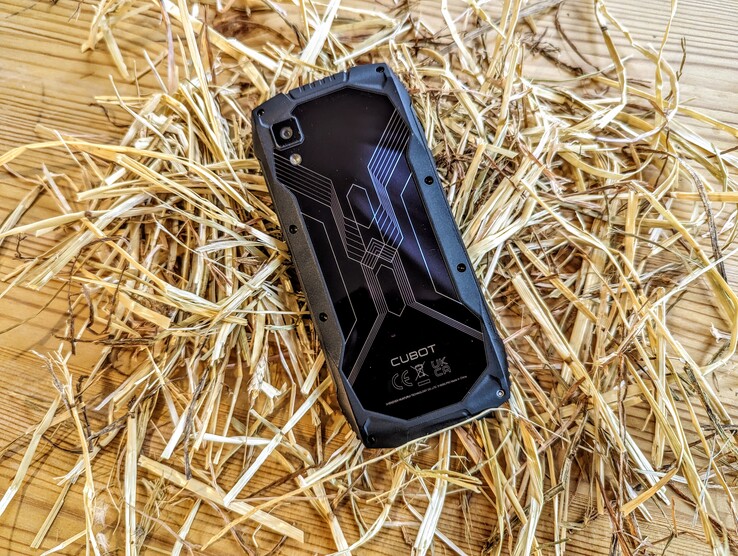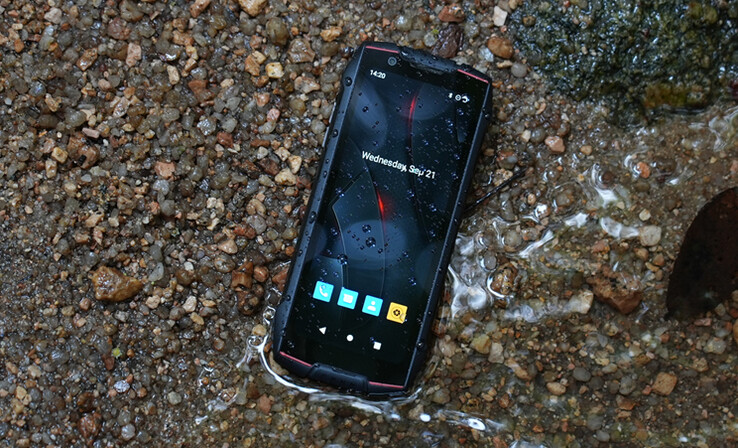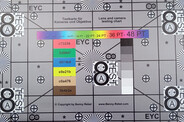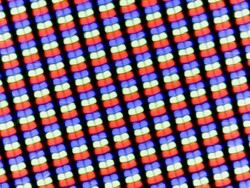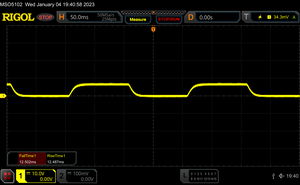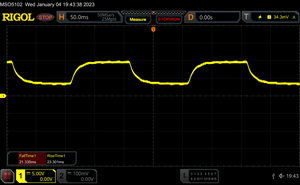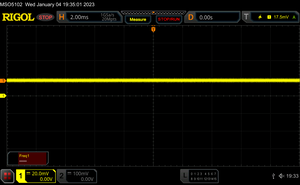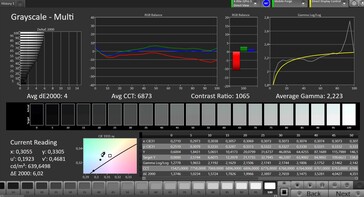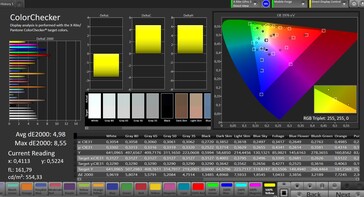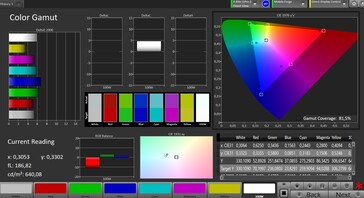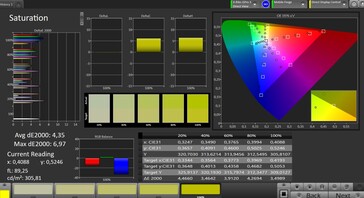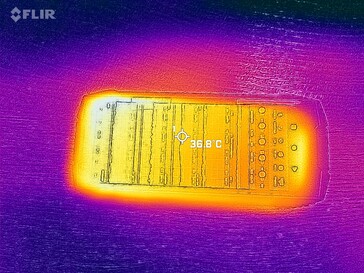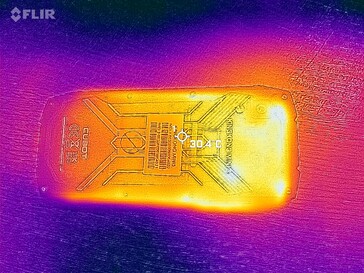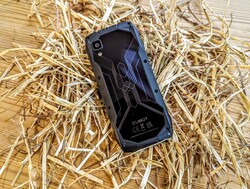Cubot KingKong Mini 3 review - Compact smartphone with reliable qualities
Possible competitors in comparison
rating | date | model | weight | drive | size | resolution | price from |
|---|---|---|---|---|---|---|---|
| 75.4 % v7 (old) | 01 / 2023 | Cubot KingKong Mini 3 Helio G85, Mali-G52 MP2 | 149 g | 128 GB eMMC Flash | 4.50" | 1170x480 | |
| 86.1 % v7 (old) | 04 / 2022 | Apple iPhone SE 2022 A15, A15 GPU 5-Core | 144 g | 64 GB SSD | 4.70" | 1334x750 | |
| 73.5 % v7 (old) | 02 / 2021 | Cubot King Kong Mini 2 Helio A22 MT6761, PowerVR GE8300 | 123 g | 32 GB eMMC Flash | 4.00" | 1080x540 | |
| 74.3 % v7 (old) | 04 / 2021 | Samsung Galaxy XCover 5 Exynos 850, Mali-G52 MP1 | 172 g | 64 GB eMMC Flash | 5.30" | 1480x720 |
Case and features - No IP certification
With a screen diagonal of only 4.5 inches, the Cubot KingKong Mini 3 is one of the smallest smartphones currently available on the market. However, since it is also an outdoor phone, the chassis is not extremely compact for the screen size, and especially the case thickness of 13.4 mm is clearly above the norm. Nevertheless, it fits very well in the pocket and also brings some color into play with its red accents.
The rubberized frame with metal inserts, visible screws, and a glossy back also gives the phone a certain style. It feels good in the hand and is also relatively light at 149 grams. The casing looks very sturdy and is supposed to resist water and dust, but the manufacturer does not specify an IP certification, so nothing is known for sure. A 5-minute bath in fresh water during our test did not affect the phone's functionality in any way.
Compared with the predecessor, the Cubot KingKong Mini 2, the manufacturer now offers much more storage: 6 GB RAM and 128 GB mass storage are on a mid-range level. However, the price has also increased significantly: while the predecessor was available from the manufacturer for just under 120 Euros, you have to pay 110 Euros more, which is almost twice as much.
In return, NFC is now also on board, but you have to do without a microSD reader.
Communication, software and operation - Few 4G frequencies
Furthermore, the Cubot KingKong Mini 3 is only a 4G phone with quite a small amount of supported frequencies, so you might have problems with the local cellular network when traveling further. The Wi-Fi 5 module, on the other hand, does a good job in our test with the reference router Asus ROG Rapture AXE11000 and delivers stable transfer rates of around 300 - 350 Mbps.
Cubot installs a fairly pure Android 12 without additional preinstalled apps. The security patches are from December 2022 and are thus still quite up-to-date at the time of testing. However, there is no information on how long the KingKong Mini 3 will get updates. The short warranty period of only 12 months is a bit annoying.
The Cubot phone does not have a fingerprint sensor. The phone can only be unlocked biometrically via facial recognition. This works quite well in good light but is somewhat insecure due to the pure software solution without additional sensors. The 60 Hz screen can be operated reliably, but you should keep in mind that the buttons on the 4.5-inch screen are very small. In return, you can easily reach the entire screen surface even with small hands.
| Networking | |
| iperf3 transmit AX12 | |
| Samsung Galaxy XCover 5 | |
| Cubot King Kong Mini 2 | |
| iperf3 receive AX12 | |
| Cubot King Kong Mini 2 | |
| Samsung Galaxy XCover 5 | |
| iperf3 transmit AXE11000 | |
| Apple iPhone SE 2022 | |
| Cubot KingKong Mini 3 | |
| iperf3 receive AXE11000 | |
| Apple iPhone SE 2022 | |
| Cubot KingKong Mini 3 | |
Cameras - Gloomy outlook
Sony's IMX350 with a maximum resolution of 20 megapixels is used as the main camera's photo sensor on the back. Even in good light, the pictures often look washed out, but at least show a certain amount of detail.
In very low light and high contrasts, the picture only succeeds in the most illuminated areas, otherwise darkness prevails. At 1 lux light intensity in our lab, nothing can be recognized in the pictures.
Videos can be recorded with a maximum of 1080p and 30 fps. Again, the picture is a bit dark, so it needs good lighting conditions. You often have to readjust the focus manually, since it does not react or only insufficiently.
There is a 5-megapixel selfie camera on the front, but it only takes poorly brightened photos that are very noisy even in average light conditions.
Image comparison
Choose a scene and navigate within the first image. One click changes the position on touchscreens. One click on the zoomed-in image opens the original in a new window. The first image shows the scaled photograph of the test device.
Main cameraMain cameraLow Light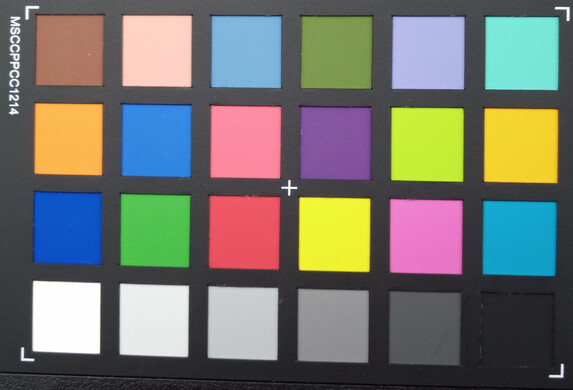

Display - The bright side of the Cubot phone
The display's resolution is very low: 1,170 x 480 pixels are only sufficient even for such a small screen. At least the maximum brightness of 624 cd/m2 is very high on average. Thus, the Cubot KingKong Mini 3 can also be used in brighter environments.
However, the brightness distribution is quite uneven, so you can see differences in individual image areas when you look closely. The black level and thus the contrast is also not optimal, and the image representation looks a bit dull.
We noticed a clearly visible blue cast in bright grayscales. The display does not use PWM for brightness reduction.
| |||||||||||||||||||||||||
Brightness Distribution: 82 %
Center on Battery: 639 cd/m²
Contrast: 1065:1 (Black: 0.6 cd/m²)
ΔE ColorChecker Calman: 4.98 | ∀{0.5-29.43 Ø4.81}
ΔE Greyscale Calman: 4 | ∀{0.09-98 Ø5.1}
81.5% sRGB (Calman 2D)
Gamma: 2.223
CCT: 6873 K
| Cubot KingKong Mini 3 IPS, 1170x480, 4.5" | Apple iPhone SE 2022 Retina HD, IPS, 1334x750, 4.7" | Cubot King Kong Mini 2 IPS, 1080x540, 4" | Samsung Galaxy XCover 5 PLS, 1480x720, 5.3" | |
|---|---|---|---|---|
| Response Times | -3% | 5% | -36% | |
| Response Time Grey 50% / Grey 80% * (ms) | 44.6 ? | 56 ? -26% | 46 ? -3% | 60 ? -35% |
| Response Time Black / White * (ms) | 25 ? | 20 ? 20% | 22 ? 12% | 34 ? -36% |
| PWM Frequency (Hz) | 354.6 ? | |||
| Screen | 35% | -15% | -16% | |
| Brightness middle (cd/m²) | 639 | 662 4% | 624 -2% | 525 -18% |
| Brightness (cd/m²) | 624 | 647 4% | 633 1% | 491 -21% |
| Brightness Distribution (%) | 82 | 92 12% | 90 10% | 87 6% |
| Black Level * (cd/m²) | 0.6 | 0.4 33% | 0.87 -45% | 0.53 12% |
| Contrast (:1) | 1065 | 1655 55% | 717 -33% | 991 -7% |
| Colorchecker dE 2000 * | 4.98 | 1.44 71% | 5.21 -5% | 5.54 -11% |
| Colorchecker dE 2000 max. * | 8.55 | 4.74 45% | 10.59 -24% | 10.23 -20% |
| Greyscale dE 2000 * | 4 | 1.7 57% | 4.8 -20% | 6.7 -68% |
| Gamma | 2.223 99% | 2.179 101% | 2.585 85% | 2.318 95% |
| CCT | 6873 95% | 6746 96% | 6953 93% | 8555 76% |
| Total Average (Program / Settings) | 16% /
28% | -5% /
-11% | -26% /
-20% |
* ... smaller is better
Display Response Times
| ↔ Response Time Black to White | ||
|---|---|---|
| 25 ms ... rise ↗ and fall ↘ combined | ↗ 12.5 ms rise | |
| ↘ 12.5 ms fall | ||
| The screen shows relatively slow response rates in our tests and may be too slow for gamers. In comparison, all tested devices range from 0.1 (minimum) to 240 (maximum) ms. » 57 % of all devices are better. This means that the measured response time is worse than the average of all tested devices (20.4 ms). | ||
| ↔ Response Time 50% Grey to 80% Grey | ||
| 44.6 ms ... rise ↗ and fall ↘ combined | ↗ 21.3 ms rise | |
| ↘ 23.3 ms fall | ||
| The screen shows slow response rates in our tests and will be unsatisfactory for gamers. In comparison, all tested devices range from 0.165 (minimum) to 636 (maximum) ms. » 75 % of all devices are better. This means that the measured response time is worse than the average of all tested devices (31.8 ms). | ||
Screen Flickering / PWM (Pulse-Width Modulation)
| Screen flickering / PWM not detected | |||
In comparison: 53 % of all tested devices do not use PWM to dim the display. If PWM was detected, an average of 8224 (minimum: 5 - maximum: 343500) Hz was measured. | |||
Performance, emissions and battery life - Mid-range power in a compact format
With the Helio G85 the manufacturer chooses a mid-range SoC that is already three years old, but still quite powerful. Thus, the phone offers considerably more power than, for example, a Samsung Galaxy XCover 5 and especially more than the predecessor. It hardly jerks once when navigating through the menu in everyday use, and even somewhat more complex apps can be displayed quite smoothly.
The storage offers the typical transfer rates of the slow eMMC flash. That is a pity, Cubot could have certainly achieved a bit more perceived speed in the system because loading and data transfers take quite a long time.
The maximum temperature of 39.4 °C on the casing is noticeable, but still within limits. Moreover, it does not affect the SoC's long-term performance, as 3DMark's stress test shows us.
The phone's earpiece also functions as a speaker, which helps direct the sound toward the user. The speaker can get quite loud but then sounds quite strained and treble-heavy. If you turn down the volume a bit, the sound becomes more balanced and you can definitely listen to a piece of music.
However, really good sound quality is achieved via headphones or external speakers, which can be connected via Bluetooth or USB-C. Supported wireless codecs are aptX, aptX HD, SBC, AAC, and LDAC.
More than a 3,000 mAh battery can hardly be found in such a compact case at present. The Cubot KingKong Mini 3 does not reach the strong runtimes of the predecessor in our Wi-Fi test, but it can still convince with 14:23 hours and should provide enough juice for several days of moderate use.
The phone charges with a maximum of 10 watts via the included charger. Thus, it takes a maximum of 2 hours for a full charge.
| PCMark for Android - Work 3.0 | |
| Average of class Smartphone (4507 - 27169, n=184, last 2 years) | |
| Average Mediatek Helio G85 (6596 - 9437, n=16) | |
| Cubot KingKong Mini 3 | |
| GFXBench | |
| on screen Aztec Ruins Normal Tier Onscreen | |
| Apple iPhone SE 2022 | |
| Average of class Smartphone (6.2 - 166, n=198, last 2 years) | |
| Cubot KingKong Mini 3 | |
| Average Mediatek Helio G85 (7.5 - 22, n=19) | |
| Samsung Galaxy XCover 5 | |
| Cubot King Kong Mini 2 | |
| 1920x1080 Aztec Ruins Normal Tier Offscreen | |
| Average of class Smartphone (3.4 - 332, n=198, last 2 years) | |
| Apple iPhone SE 2022 | |
| Average Mediatek Helio G85 (8 - 9.7, n=19) | |
| Cubot KingKong Mini 3 | |
| Samsung Galaxy XCover 5 | |
| Cubot King Kong Mini 2 | |
| on screen Aztec Ruins High Tier Onscreen | |
| Apple iPhone SE 2022 | |
| Average of class Smartphone (0.85 - 144, n=199, last 2 years) | |
| Cubot KingKong Mini 3 | |
| Average Mediatek Helio G85 (5 - 13, n=19) | |
| Samsung Galaxy XCover 5 | |
| Cubot King Kong Mini 2 | |
| 2560x1440 Aztec Ruins High Tier Offscreen | |
| Average of class Smartphone (1.2 - 129, n=198, last 2 years) | |
| Apple iPhone SE 2022 | |
| Average Mediatek Helio G85 (3.1 - 3.5, n=19) | |
| Cubot KingKong Mini 3 | |
| Samsung Galaxy XCover 5 | |
| Cubot King Kong Mini 2 | |
| Cubot KingKong Mini 3 | Cubot King Kong Mini 2 | Samsung Galaxy XCover 5 | Average 128 GB eMMC Flash | Average of class Smartphone | |
|---|---|---|---|---|---|
| AndroBench 3-5 | -29% | 55% | 45% | 799% | |
| Sequential Read 256KB (MB/s) | 277.3 | 275.5 -1% | 268.5 -3% | 297 ? 7% | 2209 ? 697% |
| Sequential Write 256KB (MB/s) | 131 | 137.8 5% | 273.6 109% | 195.2 ? 49% | 1812 ? 1283% |
| Random Read 4KB (MB/s) | 43 | 25.5 -41% | 121 181% | 85.2 ? 98% | 294 ? 584% |
| Random Write 4KB (MB/s) | 46.4 | 9.4 -80% | 14.7 -68% | 57.9 ? 25% | 339 ? 631% |
Temperature
(+) The maximum temperature on the upper side is 39.4 °C / 103 F, compared to the average of 35.2 °C / 95 F, ranging from 21.9 to 247 °C for the class Smartphone.
(+) The bottom heats up to a maximum of 35.9 °C / 97 F, compared to the average of 33.9 °C / 93 F
(+) In idle usage, the average temperature for the upper side is 21.7 °C / 71 F, compared to the device average of 32.9 °C / 91 F.
Speaker
Cubot KingKong Mini 3 audio analysis
(+) | speakers can play relatively loud (84.2 dB)
Bass 100 - 315 Hz
(-) | nearly no bass - on average 23.4% lower than median
(±) | linearity of bass is average (11.3% delta to prev. frequency)
Mids 400 - 2000 Hz
(±) | higher mids - on average 6.5% higher than median
(+) | mids are linear (6.2% delta to prev. frequency)
Highs 2 - 16 kHz
(±) | higher highs - on average 6.2% higher than median
(+) | highs are linear (6% delta to prev. frequency)
Overall 100 - 16.000 Hz
(±) | linearity of overall sound is average (24% difference to median)
Compared to same class
» 54% of all tested devices in this class were better, 8% similar, 38% worse
» The best had a delta of 12%, average was 35%, worst was 134%
Compared to all devices tested
» 71% of all tested devices were better, 6% similar, 23% worse
» The best had a delta of 4%, average was 24%, worst was 134%
Samsung Galaxy XCover 5 audio analysis
(±) | speaker loudness is average but good (79.6 dB)
Bass 100 - 315 Hz
(-) | nearly no bass - on average 32% lower than median
(±) | linearity of bass is average (12.5% delta to prev. frequency)
Mids 400 - 2000 Hz
(±) | higher mids - on average 5.8% higher than median
(+) | mids are linear (6.8% delta to prev. frequency)
Highs 2 - 16 kHz
(±) | higher highs - on average 5.4% higher than median
(+) | highs are linear (4.6% delta to prev. frequency)
Overall 100 - 16.000 Hz
(±) | linearity of overall sound is average (27.9% difference to median)
Compared to same class
» 72% of all tested devices in this class were better, 5% similar, 24% worse
» The best had a delta of 12%, average was 35%, worst was 134%
Compared to all devices tested
» 84% of all tested devices were better, 3% similar, 13% worse
» The best had a delta of 4%, average was 24%, worst was 134%
Battery life
| Battery Runtime - WiFi Websurfing | |
| Average of class Smartphone (12.1 - 54.1, n=196, last 2 years) | |
| Cubot King Kong Mini 2 | |
| Cubot KingKong Mini 3 | |
| Apple iPhone SE 2022 | |
| Samsung Galaxy XCover 5 | |
Pros
Cons
Verdict - Much more expensive, much more powerful
Ex-factory, the price of the Cubot KingKong Mini 3 has almost doubled compared to the predecessor. However, it has already dropped considerably on the Internet and the new model also comes with some improvements: the most obvious is the increased performance, which is now on a mid-range level and is usually sufficient for smooth system operation.
Then there is NFC, which will please all friends of mobile payment services. The speaker does a decent job and the display is still very bright on demand.
It remains in the dark how robust the phone actually is against forces of nature, although it survived our dive in the test without any problems. An IP certification would have been helpful here.
The small display has advantages like the convenience and easy one-handed operation, but also problems due to the very small buttons. We are not convinced by the cameras, which hardly achieve any brightness and often produce washed-out or noisy pictures.
Smartphones as handy as the Cubot KingKong Mini 3 are hardly available anymore. In addition, there is now mid-range performance and a bright screen, but still hardly usable cameras.
The Samsung Galaxy XCover 5 is considerably bigger, but still a bit more handy than other phones and also robust. However, it offers considerably less powerful. If you want a lot of performance in a small format with an IP certification, you can go for the iPhone SE 2022 but its price is considerably higher.
Price and availability
The Cubot KingKong Mini 3 is available at amazon.de, for example. The price also dropped considerably at the time of the review. The phone is sold for approximately 166 Euros (~$166).
Cubot KingKong Mini 3
- 01/16/2023 v7 (old)
Florian Schmitt




